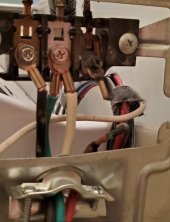My Mother-in-law's dryer stopped working. Pulled off the back power panel, and found this. A combination of, what I assume is, corrosion from the moist environment, and a loose strain relief caused a hot wire to somewhat slip out of the crimp terminal, spark and melt under load, until it finally slipped out and shorted to ground against the dryer case. Yikes. That particular dryer was professionally installed.


I just went around our house and double checked all of our appliances for tight strain relief screws.


I just went around our house and double checked all of our appliances for tight strain relief screws.


